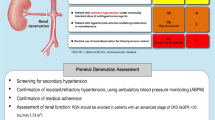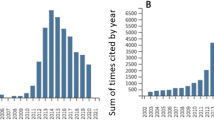Abstract
Purpose of Review
This review was undertaken to update readers on the field of therapeutic renal denervation for hypertension during the 2016 through 2018 period.
Recent Findings
After the failure of Symplicity HTN-3 to meet its top line objective, intense scrutiny revealed several possible concerns addressed by the newer investigations into the area of renal denervation. These included better device technology, more intense subject monitoring for off-protocol antihypertensive drug usage, and deeper penetration into the renal vasculature by the interventionist.
Summary
Whether untreated by medication for hypertension or on antihypertensive medication, renal denervation shows a clear, though moderate, blood pressure reduction. The failure of roughly one out of three patients with hypertension to respond to denervation procedures argues that there is room for improvement in choosing the optimal patient for this approach to hypertension management.


Similar content being viewed by others
References
Papers of particular interest, published recently, have been highlighted as: • Of importance •• Of major importance
•• Krum H, et al. Catheter-based renal sympathetic denervation for resistant hypertension: a multicentre safety and proof-of-principle cohort study. Lancet. 2009;373(9671):1275–81. First human series of patients treated for drug resistant hypertension using radiofrequency renal ablation.
Esler MD, et al. Renal sympathetic denervation in patients with treatment-resistant hypertension (the Symplicity HTN-2 trial): a randomised controlled trial. Lancet. 2010;376(9756):1903–9.
Kandzari DE, et al. Catheter-based renal denervation for resistant hypertension: rationale and design of the SYMPLICITY HTN-3 trial. ClinCardiol. 2012;35(9):528–35.
Bhatt DL, Kandzari DE, O'Neill WW, D'Agostino R, Flack JM, Katzen BT, et al. A controlled trial of renal denervation for resistant hypertension. N Engl J Med. 2014;370(15):1393–401.
Messerli FH, Bangalore S. Renal denervation for resistant hypertension? N Engl J Med. 2014;370(15):1454–7.
Kandzari DE, et al. Predictors of blood pressure response in the SYMPLICITY HTN-3 trial. In: Eur.Heart J, vol. 36; 2014. p. 219–27.
Townsend RR, Mahfoud F, Kandzari DE, Kario K, Pocock S, Weber MA, et al. Catheter-based renal denervation in patients with uncontrolled hypertension in the absence of antihypertensive medications (SPYRAL HTN-OFF MED): a randomised, sham-controlled, proof-of-concept trial. Lancet. 2017;390(10108):2160–70.
Fischell TA, Ebner A, Gallo S, Ikeno F, Minarsch L, Vega F, et al. Transcatheter alcohol-mediated perivascular renal denervation with the Peregrine system: first-in-human experience. JACC Cardiovasc Interv. 2016;9(6):589–98.
Azizi M, Schmieder RE, Mahfoud F, Weber MA, Daemen J, Davies J, et al. Endovascular ultrasound renal denervation to treat hypertension (RADIANCE-HTN SOLO): a multicentre, international, single-blind, randomised, sham-controlled trial. Lancet. 2018;391(10137):2335–45.
•• Jung O, et al. Resistant hypertension? Assessment of adherence by toxicological urine analysis. J Hypertens. 2013;31(4):766–74. Important study which highlighted the substantial prevalence of drug-non-adherence in resistant hypertebnsion.
Florczak E, et al. Assessment of adherence to treatment in patients with resistant hypertension using toxicological serum analysis. A subgroup evaluation of the RESIST-POL study. Pol Arch Med Wewn. 2015;125(1–2):65–72.
Patel P, Gupta PKC, White CMJ, Stanley AG, Williams B, Tomaszewski M. Screening for non-adherence to antihypertensive treatment as a part of the diagnostic pathway to renal denervation. J Hum Hypertens. 2016;30(6):368–73.
Kandzari DE, Böhm M, Mahfoud F, Townsend RR, Weber MA, Pocock S, et al. Effect of renal denervation on blood pressure in the presence of antihypertensive drugs: 6-month efficacy and safety results from the SPYRAL HTN-ON MED proof-of-concept randomised trial. Lancet. 2018;391(10137):2346–55.
Flack JM, et al. An analysis of the blood pressure and safety outcomes to renal denervation in African Americans and non-African Americans in the SYMPLICITY HTN-3 trial. J Am Soc Hypertens. 2015;9:769–79.
•• Mahfoud F, et al. Reduced blood pressure-lowering effect of catheter-based renal denervation in patients with isolated systolic hypertension: data from SYMPLICITY HTN-3 and the global SYMPLICITY registry. Eur Heart J. 2017;38(2):93–100. This registry will be an important source of long-term efficacy and saftery of renal denervation.
• Sata Y, et al. Ambulatory arterial stiffness index as a predictor of blood pressure response to renal denervation. J Hypertens. 2018;36(6):1414–22. Given the difficulty predicting responses in RDN studies like this are going to become inreasingly important as subject selection is streamlined.
•• Osborn JW, Foss JD. Renal nerves and long-term control of arterial pressure. Compr Physiol. 2017;7(2):263–320. Well-written and comprehensive review or renal nerve anatomy and role in renal function.
Petrov I, Tasheva I, Garvanski I, Stankov Z, Simova I. Comparison of standard renal denervation procedure versus novel distal and branch vessel ablation with brachial arterial access. In: Cardiovasc Revasc Med; 2018. https://doi.org/10.1016/j.carrev.2018.05.011.
Mahfoud F, Tunev S, Ewen S, Cremers B, Ruwart J, Schulz-Jander D, et al. Impact of lesion placement on efficacy and safety of catheter-based radiofrequency renal denervation. J Am Coll Cardiol. 2015;66(16):1766–75.
Fudim M, Sobotka AA, Yin YH, Wang JW, Levin H, Esler M, et al. Selective vs. global renal denervation: a case for less is more. Curr Hypertens Rep. 2018;20(5):37.
Tsioufis C, Dimitriadis K, Tsioufis P, Patras R, Papadoliopoulou M, Petropoulou Z, et al. ConfidenHT system for diagnostic mapping of renal nerves. Curr Hypertens Rep. 2018;20(6):49.
DiBona GF, Kopp UC. Neural control of renal function. Physiol Rev. 1997;77(1):75–197.
Kopp UC. Role of renal sensory nerves in physiological and pathophysiological conditions. Am J Physiol Regul Integr Comp Physiol. 2015;308(2):R79–95.
Kopp UC, et al. Renal sympathetic nerve activity modulates afferent renal nerve activity by PGE2-dependent activation of alpha1- and alpha2-adrenoceptors on renal sensory nerve fibers. Am J Physiol Regul Integr Comp Physiol. 2007;293(4):R1561–72.
Ueda H, Uchida Y, Kamisaka K. Mechanism of the reflex depressor effect by the kidney in dog. Jpn Heart J. 1967;8(6):597–606.
Handa RK, Johns EJ. Interaction of the renin–angiotensin system and the renal nerves in the regulation of rat kidney function. J Physiol. 1985;369:311–21.
DiBona GF. Physiology in perspective: the wisdom of the body. Neural control of the kidney. Am J Physiol Regul Integr Comp Physiol. 2005;289(3):R633–41.
Fudim M, Hernandez AF, Felker GM. Role of volume redistribution in the congestion of heart failure. J Am Heart Assoc. 2017;6(8):e006817.
Lambert T, Nahler A, Reiter C, Schwarz S, Gammer V, Blessberger H, et al. Frequency of renal artery stenosis after renal denervation in patients with resistant arterial hypertension. Am J Cardiol. 2015;115(11):1545–8.
•• Pappaccogli, M., et al., Effectiveness of renal denervation in resistant hypertension: a meta-analysis of 11 controlled studies. High Blood Press Cardiovasc Prev, 2018. https://doi.org/10.1007/s40292-018-0260-5. Accessed 11 May 2018. This analysis was published before more recent studies. It basically finds little benefit in RDN as done in the period up to about 2016 .
Author information
Authors and Affiliations
Corresponding author
Ethics declarations
Conflict of Interest
Dr. Townsend reports personal fees from Medtronic and Rox Medical, outside the submitted work. Dr. Sobotka is Executive Consultant to Rox Medical.
Human and Animal Rights and Informed Consent
This article does not contain any studies with human or animal subjects performed by any of the authors.
Additional information
This article is part of the Topical Collection on Hypertension and the Kidney
Rights and permissions
About this article
Cite this article
Townsend, R.R., Sobotka, P.A. Catheter-Based Renal Denervation for Hypertension. Curr Hypertens Rep 20, 93 (2018). https://doi.org/10.1007/s11906-018-0896-5
Published:
DOI: https://doi.org/10.1007/s11906-018-0896-5




